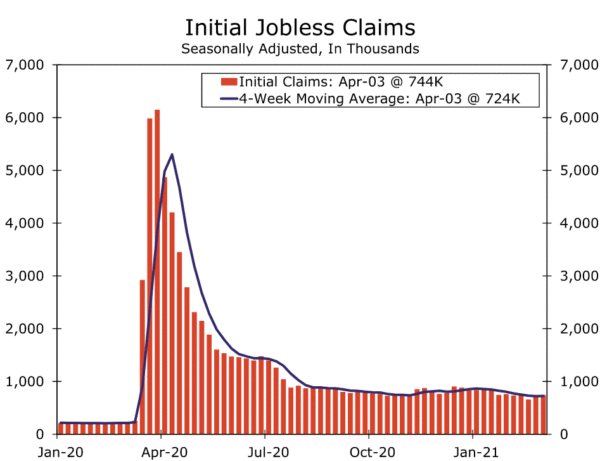Summary
The second consecutive increase in weekly claims to 744K and the modest increase in the four-week average stand in contrast to nearly all other reads on the labor market at present, which point to the recovery progressing.
One of These Things Is Not Like the Other
Initial jobless claims rose for a second straight week, coming in at 744K. The increase over the past two weeks was enough to nudge the four-week average up for the first time since January of this year.
The recent rise in claims stands in contrast to almost all other readings of the labor market at present. Hiring has picked up substantially, with 916K jobs added in March. Business surveys corroborate stronger job growth, with the ISM manufacturing and services employment indices both jumping last month. Job openings according to both the BLS and Indeed.com have surpassed their pre-COVID levels. And even from households’ perspective, the labor market has improved recently, with the difference between the share of consumers viewing jobs as “plentiful” versus “hard to get” in March seeing its biggest jump since June.
In other words, there is little to suggest that the labor market recovery is once again stalling, let alone backsliding, as recent claims figures hint. Instead, the sideways move likely reflects the usual weekly noise—made especially difficult this time of year by the variable timing of Easter—as well as ongoing issues related to backlogs, substantial churn in some industries and even fraud.
Little Change to Total Number of Benefit Recipients
Four million workers were receiving regular benefits through the week ending March 27, down from almost 23M at the height of the crisis. That, however, misses the growing number of workers unemployed for six months or more, which hit a cycle high of 43% in March; there were another 6.4M workers on extended benefit programs though March 20. Meanwhile, continuing claims under the Pandemic Unemployment Assistance program, the emergency program to cover gig workers and the self-employed among others, was little changed. All told, continuing claims totaled 18.2M in the most recent week that data are available across all programs and points to unemployment insurance remaining a substantial source of household income at this time.
Calling It Quits
For all the issues surrounding claims filings this past year, their recalcitrance is a reminder that the labor market is far from fully heeled. Yet the improving public health picture and ample policy support should push both initial and continuing claims lower in the months to come. We will be keeping an eye on claims to gauge the pace of the labor market’s recovery. But with the worst of the crisis seemingly over and the week-to-week readings on claims diminishing in efficacy, we will no longer be writing on the release each Thursday morning as we have for the past year.


 Signal2forex.com - Best Forex robots and signals
Signal2forex.com - Best Forex robots and signals




